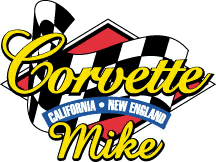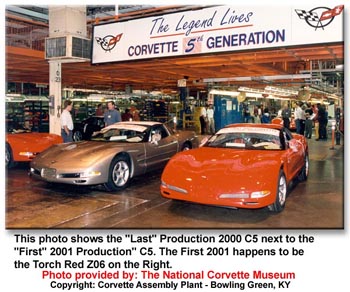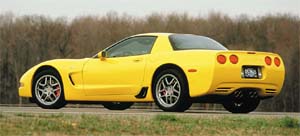 |
Corvette
Mike is proud to bring you
the Visit our Website at: www.corvettemike.com for Sales • Service • Parts • Restoration • Wheels • Installation |
||||||||||||||||||||||||||||||||||||||||||||||||||||||||||||||||||||||||||||||||||||||||||||||||||||||||||||||||||||||||
|
The Fifth-Generation C5 CORVETTE
The C5 was introduced as a 1997 model (coupe only) in March, 1997. The C5 convertible followed in the fall of 1997 and debuted as a 1998 model. In the 1999 model year a fixed-roof hardtop model - the lightest, stiffest and quickest model in the Corvette family - came onto the scene. For 2001, the hardtop model becomes the Z06.
Sales & Market Penetration Corvette has long been the leader in the U.S. High Sports market segment. The introduction of the C5 coupe, along with subsequent introductions of the convertible and hardtop models, has helped Corvette to maintain leadership, even in the face of strong recent competition. The following statistics, gathered from various sources by the Corvette Brand Team, serve to illustrate the battle that has been raging since 1995 in the U.S.
(1)= Corvette C5 introduced in March, 1997 Styling When Chevy Studio designers redid the Corvette for 1997 they took great care to be sure that the car included several styling cues from the past, while giving it a fresh new look with much better aerodynamic characteristics. Four almost-round taillights, a Corvette styling signature evocative of many previous models, grace the rear of the car. The design of the instrument cluster, with analog-style instruments, is also reminiscent of early models. It includes unique black light illumination and a sophisticated electronic driver information center with readouts in four languages. A passenger "grab handle", similar to that found in Corvettes of the mid-60's, is also included.
On the C5 convertible a sleek "waterfall" panel, another feature from the 50's, reappeared between the seats. Last but not least, the Corvette's body is still made of fiberglass, albeit a much-improved variety that is highly crack-resistant and allows the Bowling Green plant to provide the smoothest, most blemish-free Corvette exterior finish ever. Backbone Structure The C5 Corvette structure, consisting of a strong perimeter frame combined with a center backbone, provides an impressive level of rigidity. This robust design allows Corvette's independent suspension to be tuned precisely for driver control and freedom from impact harshness. The C5 Corvette was designed to be a convertible, even though the convertible didn't actually debut until a year after the coupe. As a result, the C5 convertible has received accolades for its structural integrity, great noise isolation and relatively low level of wind buffeting during top-down operation. In 1999 a fixed roof hardtop model was added to the lineup - becoming the stiffest, lightest and quickest Corvette available. It was offered only with the 6-speed manual transmission and the Z51 Performance suspension. The Corvette Team indicated right from the beginning that the hardtop would be further developed in the performance dimension, and with the introduction of the Z06 that promise has been kept. Safety & Security Powertrain The sweetest small-block of all arrived in the new C5 in 1997. The GEN III LS1 was a clean-sheet design. Featuring an aluminum block, it enabled GM powertrain engineers to take advantage of inherent design strengths of the original small-block while eliminating virtually every one of its weaknesses. From top to bottom the new LS1 is new and different - the only commonality between it and the original Chevy Small-Block of 1955 being its 4-inch bore centers. |
|||||||||||||||||||||||||||||||||||||||||||||||||||||||||||||||||||||||||||||||||||||||||||||||||||||||||||||||||||||||||
 Model
Lineup
Model
Lineup A
stylized side "cove" in the bodywork behind the front wheels
harkens back to the Corvettes of the 50's, and the famed Corvette
"crossed-flags" emblem returned with a new, more modern
look.
A
stylized side "cove" in the bodywork behind the front wheels
harkens back to the Corvettes of the 50's, and the famed Corvette
"crossed-flags" emblem returned with a new, more modern
look.